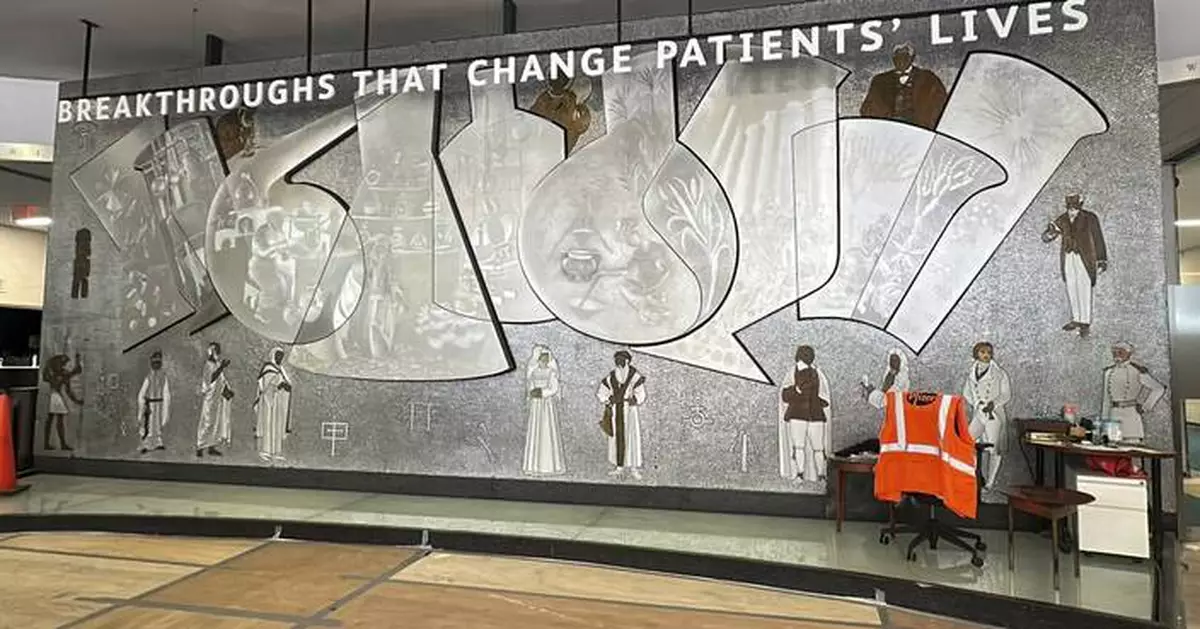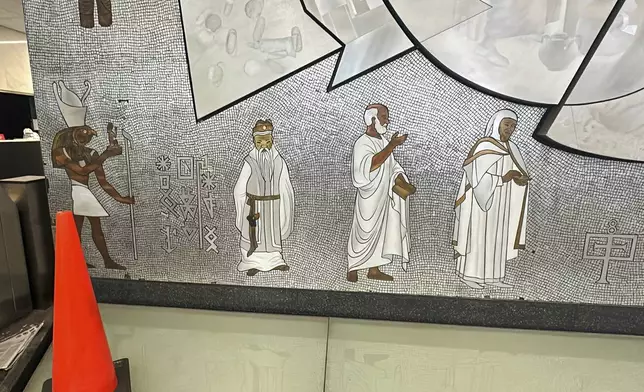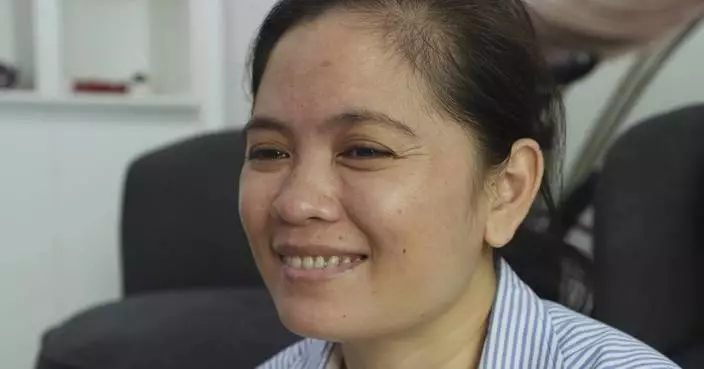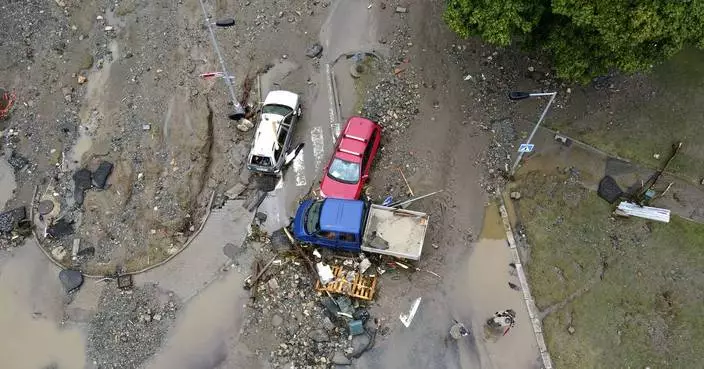NEW YORK (AP) — A mural honoring ancient and modern figures in medicine that has hung in the lobby of Pfizer’s original New York City headquarters for more than 60 years could soon end up in pieces if conservationists can’t find a new home for it in the next few weeks.
“Medical Research Through the Ages,” a massive metal and tile mosaic depicting scientists and lab equipment, has been visible through the high glass-windowed lobby of the pharmaceutical giant’s midtown Manhattan office since the 1960s.
Click to Gallery
NEW YORK (AP) — A mural honoring ancient and modern figures in medicine that has hung in the lobby of Pfizer’s original New York City headquarters for more than 60 years could soon end up in pieces if conservationists can’t find a new home for it in the next few weeks.
This undated photo shows Nikos Bel-Jon in his New York Studio on East 72 Street in front of a model of the massive metal mural he built for Pfizer's world headquarters in 1961. (Rhea Bel-Jon Calkins via AP)
An image of Dr. Edward Jenner, who discovered a vaccine for smallpox, is part of a metal mosaic mural created in 1960 by Greek-born artist Nikos Bel-Jon titled "Medical Research Through the Ages," seen in the lobby of the old Pfizer headquarters in New York on Thursday, August 29, 2024. (AP Photo/Ted Shaffrey)
An image of a Sister of St. Martha, representative of women who devoted their lives to nursing the sick; and an image of Andres Vesalius, known as the founder of modern anatomy; are part of a metal mosaic mural created in 1960 by Greek-born artist Nikos Bel-Jon titled "Medical Research Through the Ages," seen in the lobby of the old Pfizer headquarters in New York on Thursday, August 29, 2024. (AP Photo/Ted Shaffrey)
Images, from left, of Horus, Egyptian mythology god; Emperor Shen-Nung; Hippocrates; and Doctor of Salerno; are part of a metal mosaic mural created in 1960 by Greek-born artist Nikos Bel-Jon titled "Medical Research Through the Ages," seen in the lobby of the old Pfizer headquarters in New York on Thursday, August 29, 2024. (AP Photo/Ted Shaffrey)
A metal mosaic mural created in 1960 by Greek-born artist Nikos Bel-Jon and titled "Medical Research Through the Ages" is in the lobby of the old Pfizer headquarters in New York on Thursday, August 29, 2024. (AP Photo/Ted Shaffrey)
But the building is being gutted and converted into residential apartments, and the new owners have given the mural a move-out date of as soon as Sept. 10.
Art conservationists and the late artist’s daughters are now scrambling to find a patron who is able to cover the tens of thousands of dollars they estimate it will take to move and remount it, as well as an institution that can display it.
“I would ideally like to see it as part of an educational future, whether it’s on a hospital campus as part of a school or a college. Or part of a larger public art program for the citizens of New York City,” said art historian and urban planner Andrew Cronson, one of the people trying to find a new home for the piece.
The 36-foot-wide and 14-foot-high (11 meters by 4.3 meters) mural by Greek American artist Nikos Bel-Jon was the main showpiece of Pfizer’s world headquarters when the building opened a few blocks from Grand Central Terminal in 1961, at a time when flashy buildings and grand corporate art projects were a symbol of business success. He died in 1966, leaving behind dozens of large brushed-metal works commissioned by companies and private institutions, many of which have now been lost or destroyed.
In recent years, Pfizer sold the building — and last year moved its headquarters to a shared office space in a newer property. The company said in an emailed statement that it decided the money needed to deconstruct, relocate and reinstall the mural elsewhere would be better spent on “patient-related priorities.”
The developer now turning the building into apartments, Metro Loft, doesn't want to keep the artwork either, though it has been working with those trying to save the piece with help like letting art appraisers in. The company declined to comment further, but Jack Berman, its director of operations, confirmed in an email that it needs to get the mural out.
Bel-Jon’s youngest daughter, Rhea Bel-Jon Calkins, said they’ve gotten some interest from universities who could take the piece, and a Greek cultural organization that could help fundraise for the move. But the removal alone could cost between $20,00 and $50,000, according to estimates cited by Cronson.
If they can’t immediately find a taker, the mural won’t end up in landfill, Bel-Jon Calkins said. But it would have to be broken up into pieces — nine metal sections and eight mosaic sections — and moved into storage, likely with some of her relatives.
Time is ticking away. Workers gutting the building have been carrying out ripped-up carpeting, drab office chairs and piles of scrap wood and loading them into garbage trucks.
For the past few decades, the artwork's metal — brushed tin and aluminum panels in the shape of laboratory beakers, funnels and flasks, surrounded by symbols, alchemists and scientists — has been a dull gray and white. But Bel-Jon Calkins remembers its original, multicolored lighting scheme.
“As you moved, the color moved with you and changed. So there was a constant dynamic to the mural that no one really has ever been able to achieve,” she said.
Richard McCoy, director of the Indiana nonprofit Landmark Columbus Foundation, which cares for local buildings and landscapes, said the piece might lack commercial value, describing Bel-Jon as “extraordinary, but not super well-known.”
“But then you realize 20 or 30 years from then how great it was,” he said, adding that it might merit preservation for its historical value.
Bel-Jon Calkins tracks her father’s 42 large-scale metal murals in a spreadsheet and on the artist's website. She said only about a dozen are confirmed to exist.
A 12-foot (3.6-meter) metal mosaic depicting saints and commissioned by a Greek Orthodox church in San Francisco was destroyed in the Loma Prieta earthquake of 1989. General Motors commissioned a hubcap-shaped metal mural that was larger than a car for a trade show, but she confirmed it was later melted down into scrap.
“It’s the corporations that have lost them,” she said in a phone conversation from her home in San Miguel de Allende, Mexico. “They valued them enough to commission them but not enough to preserve them.”
This story was first published on Sep. 7, 2024. It was updated on Sep. 9, 2024 to correct the size of the mural, which is 36 feet (11 meters) wide and 14 feet (4.3 meters) tall, not 40 feet (12 meters) wide and 18 feet (5.5 meters) tall.
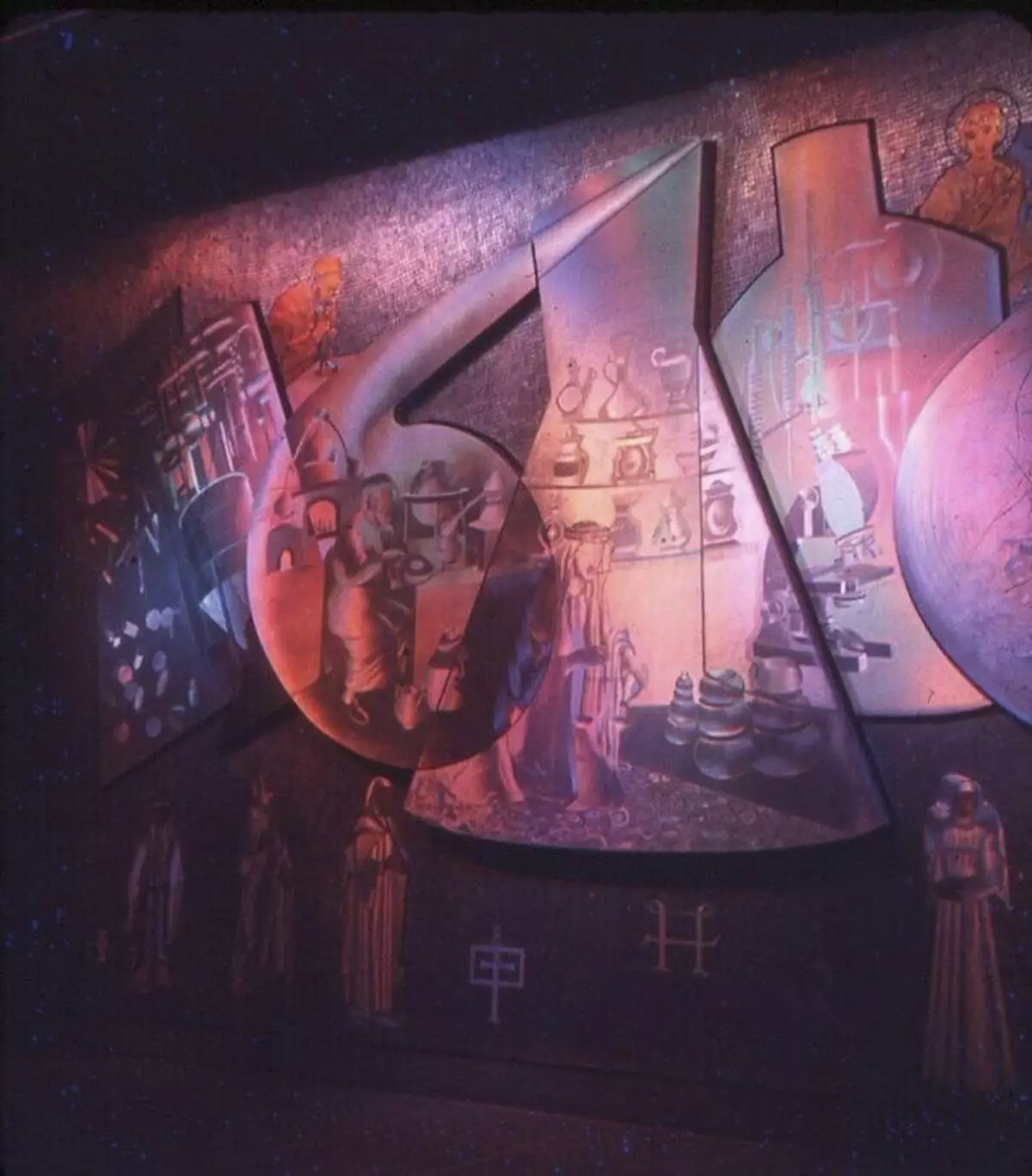
This undated photo shows the massive "Medical Research Through the Ages" mural at Pfizer's 1961 world headquarters in New York with its original multicolored lighting setup. (Rhea Bel-Jon Calkins via AP)
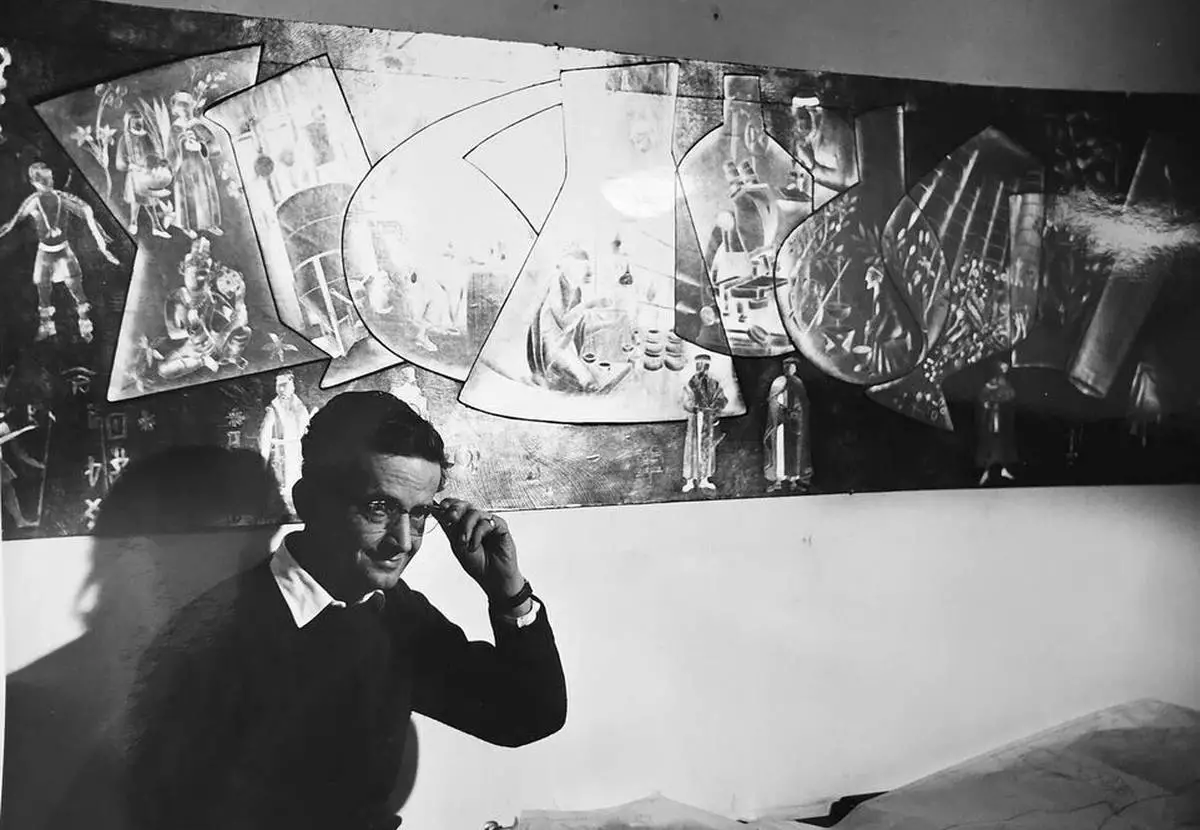
This undated photo shows Nikos Bel-Jon in his New York Studio on East 72 Street in front of a model of the massive metal mural he built for Pfizer's world headquarters in 1961. (Rhea Bel-Jon Calkins via AP)
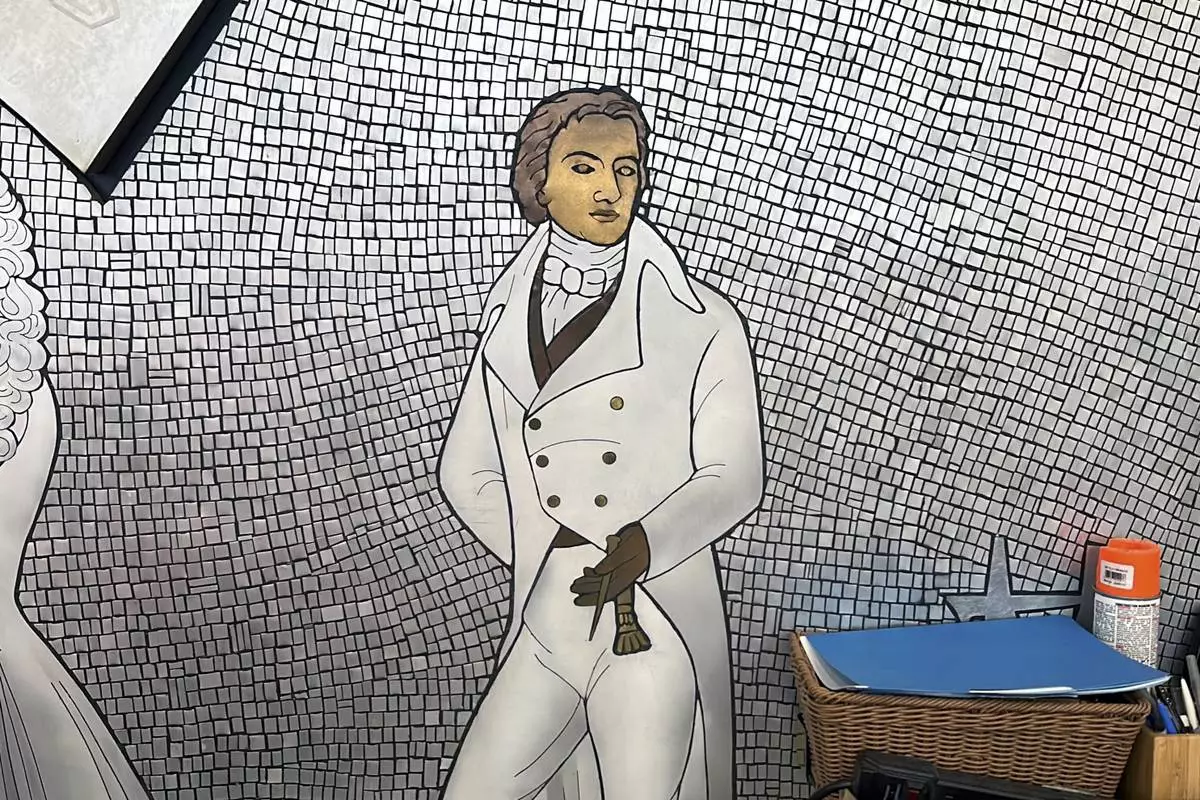
An image of Dr. Edward Jenner, who discovered a vaccine for smallpox, is part of a metal mosaic mural created in 1960 by Greek-born artist Nikos Bel-Jon titled "Medical Research Through the Ages," seen in the lobby of the old Pfizer headquarters in New York on Thursday, August 29, 2024. (AP Photo/Ted Shaffrey)
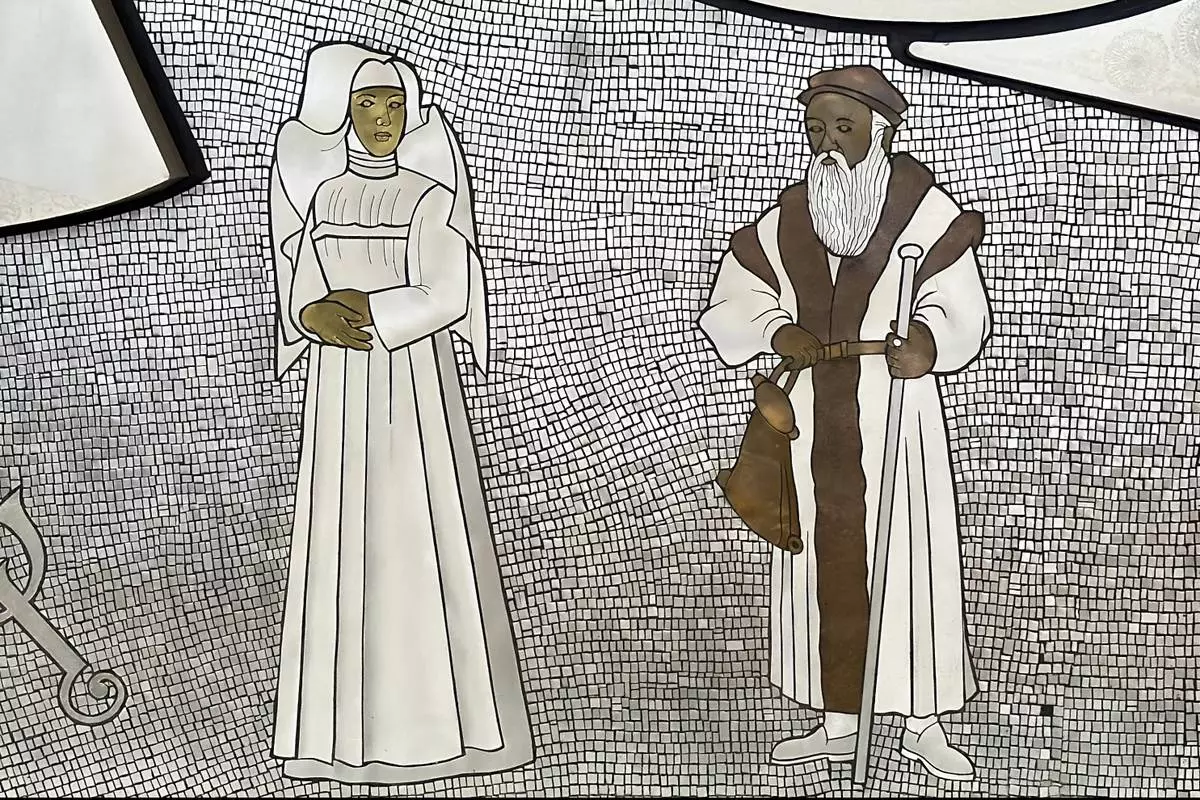
An image of a Sister of St. Martha, representative of women who devoted their lives to nursing the sick; and an image of Andres Vesalius, known as the founder of modern anatomy; are part of a metal mosaic mural created in 1960 by Greek-born artist Nikos Bel-Jon titled "Medical Research Through the Ages," seen in the lobby of the old Pfizer headquarters in New York on Thursday, August 29, 2024. (AP Photo/Ted Shaffrey)

Images, from left, of Horus, Egyptian mythology god; Emperor Shen-Nung; Hippocrates; and Doctor of Salerno; are part of a metal mosaic mural created in 1960 by Greek-born artist Nikos Bel-Jon titled "Medical Research Through the Ages," seen in the lobby of the old Pfizer headquarters in New York on Thursday, August 29, 2024. (AP Photo/Ted Shaffrey)

A metal mosaic mural created in 1960 by Greek-born artist Nikos Bel-Jon and titled "Medical Research Through the Ages" is in the lobby of the old Pfizer headquarters in New York on Thursday, August 29, 2024. (AP Photo/Ted Shaffrey)
WASHINGTON (AP) — American consumers and home buyers, business people and political leaders have been waiting for months for what the Federal Reserve is poised to announce this week: That it's cutting its key interest rate from a two-decade peak.
It's likely to be just the first in a series of rate cuts that should make borrowing more affordable now that the Fed has deemed high inflation to be all but defeated.
Consider Kelly Mardis, who owns Marcel Painting in Tempe, Arizona. About a quarter of Mardis' business comes from real estate agents who are prepping homes for sale or from new home buyers. Customer queries, he recalls, quickly dropped almost as soon as the Fed started jacking up interest rates in March 2022 — and then kept raising rates through July 2023.
As the housing market contracted, Mardis had to lay off about half his staff of 30. It was the worst dry spell he had experienced in 14 years.
After the Fed begins cutting rates on Wednesday, Mardis envisions brighter times ahead. Typically, a succession of Fed rate cuts leads over time to lower borrowing costs for things like mortgages, auto loans, credit cards and business loans.
“I'm 100% sure it would make a difference,” Mardis said. “I'm looking forward to it.”
At the same time, plenty of uncertainty still surrounds this week's Fed meeting.
How much will the policymakers decide to reduce their benchmark rate, now at 5.3%? By a traditional quarter-point or by an unusually large half-point?
Will they keep loosening credit at their subsequent meetings in November and December and into 2025? Will lower borrowing costs take effect in time to bolster an economy that is still growing at a solid pace but is clearly showing cracks?
Chair Jerome Powell emphasized in a speech last month in Jackson Hole, Wyoming, that the Fed is prepared to cut rates to support the job market and achieve a notoriously difficult “soft landing.” That is when the central bank manages to curb inflation without tipping the economy into a steep recession and causing unemployment to surge.
It's not entirely clear that the Fed can pull it off.
One hopeful sign is that as Powell and other Fed officials have signaled that rate cuts are coming, many interest rates have already fallen in anticipation. The average 30-year mortgage rate dropped to 6.2% last week — the lowest level in about 18 months and down from a peak of nearly 7.8%, according to the mortgage giant Freddie Mac. Other rates, like the yield on the five-year Treasury note, which influences auto loan rates, have also tumbled.
“That really does help lower those borrowing costs across the board," said Kathy Bostjancic, chief economist at Nationwide Financial. “That helps to give nice relief to consumers.”
Businesses can now borrow at lower rates than they've been able to for the past year or so, potentially boosting their investment spending.
“The question is if it's helping quickly enough ... to actually deliver the soft landing that everyone's been hoping for," said Gennadiy Goldberg, head of U.S. rates strategy at TD Securities.
Many economists would like to see the Fed announce a half-point rate cut this week, in part because they think the officials should have begun cutting rates at their previous meeting in July. Wall Street traders on Friday signaled their expectation that the Fed will carry out at least two half-point cuts by year's end, according to futures prices.
Yet Goldberg suggested that there would be downsides to implementing a half-point rate cut this week. It might signal to the markets that the Fed's policymakers are more worried about the economy than they actually are.
“Markets could assume that something is wrong and the Fed sees something quite terrible on the horizon,” Goldberg said.
It could also raise expectations for additional half-point cuts that the Fed might not deliver.
In the long run, more important than Wednesday's Fed action is the pace of rate cuts through next year and the ultimate end point. If Fed officials conclude that inflation is essentially defeated and they no longer need to slow the economy, that would suggest that their key rate should be at a more “neutral” setting, which could be as low as 3%. That would require a series of further rate cuts.
Many economists think the economy needs much lower rates. Diane Swonk, chief economist at KPMG, notes that hiring has averaged just 116,000 a month for the past three months, a level equivalent to the sluggish job growth coming out of the 2008-2009 Great Recession. The unemployment rate has risen by nearly a full percentage point to 4.2%.
“There is a fragility out there when you are not hiring at a very strong pace," Swonk said. “This is still a much weaker labor market then we thought we had.”
Still, Fed rate cuts may provide a crucial boost to the economy just when it's needed.
Michele Raneri, head of U.S. research at TransUnion, a credit monitoring company, noted that lower rates typically lead consumers to refinance high interest-rate debt — principally credit card borrowing — into lower-cost personal loans. Doing so would ease their financial burdens.
And once mortgage rates fall below 6%, Raneri said, more homeowners will likely be willing to sell, rather than holding on to their house out of reluctance to swap a low mortgage rate for a much higher one. More home sales would help relieve the supply crunch that's made it hard for younger people to buy a first home.
“That starts to break up this logjam that we’ve been in where there’s a low inventory of houses,” Raneri said. “We need some people to start moving to start that churn.”
Other small businesses are seeing signs that the churn is picking up. Brittany Hart, who owns a software consulting firm in Phoenix that works with mortgage brokers, wealth managers and banks, is noticing more interest from potential clients in adopting new software to boost efficiency. That is because they expect the housing market to pick up.
Hart has started looking for three new employees to help handle the expected business, to add to the roughly 20 employees she has now.
“This is the first leading indicator that we are getting back to that normal activity in the housing market," she said.
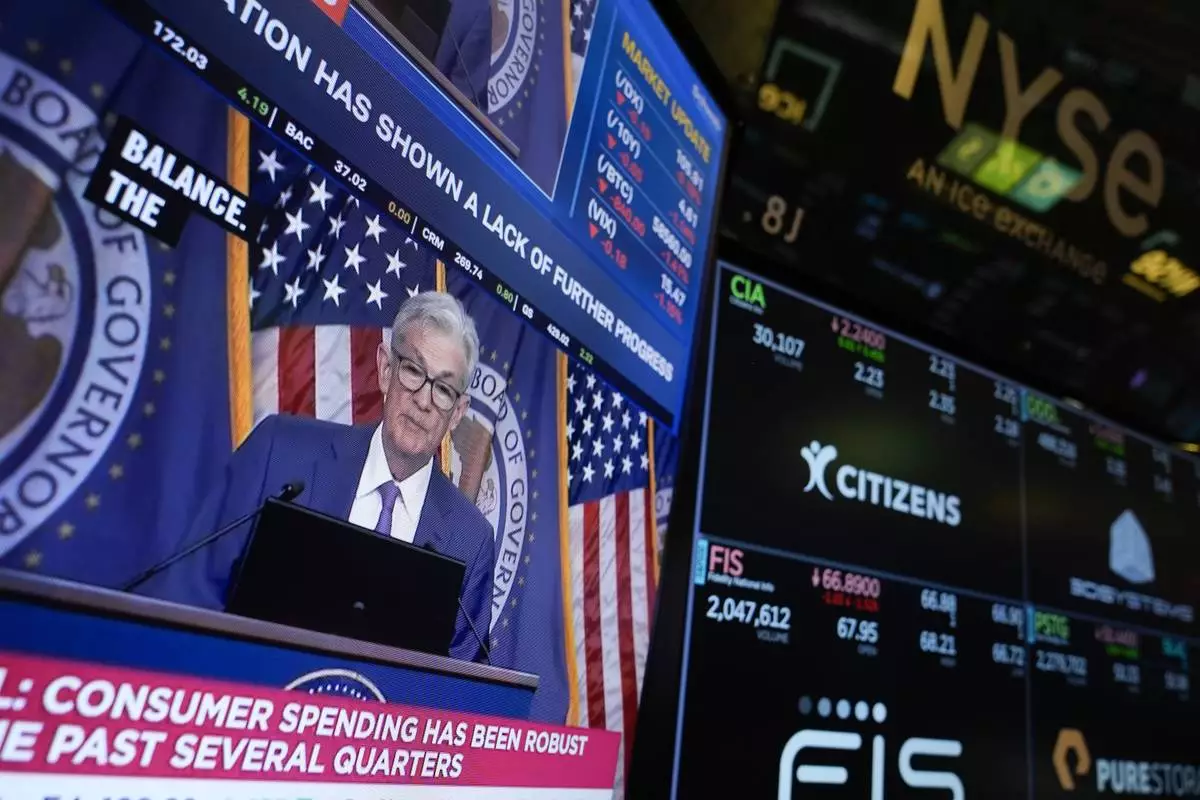
FILE - A screen displays a news conference with Federal Reserve Chairman Jerome Powell on the floor at the New York Stock Exchange in New York, May 1, 2024. (AP Photo/Seth Wenig, File)
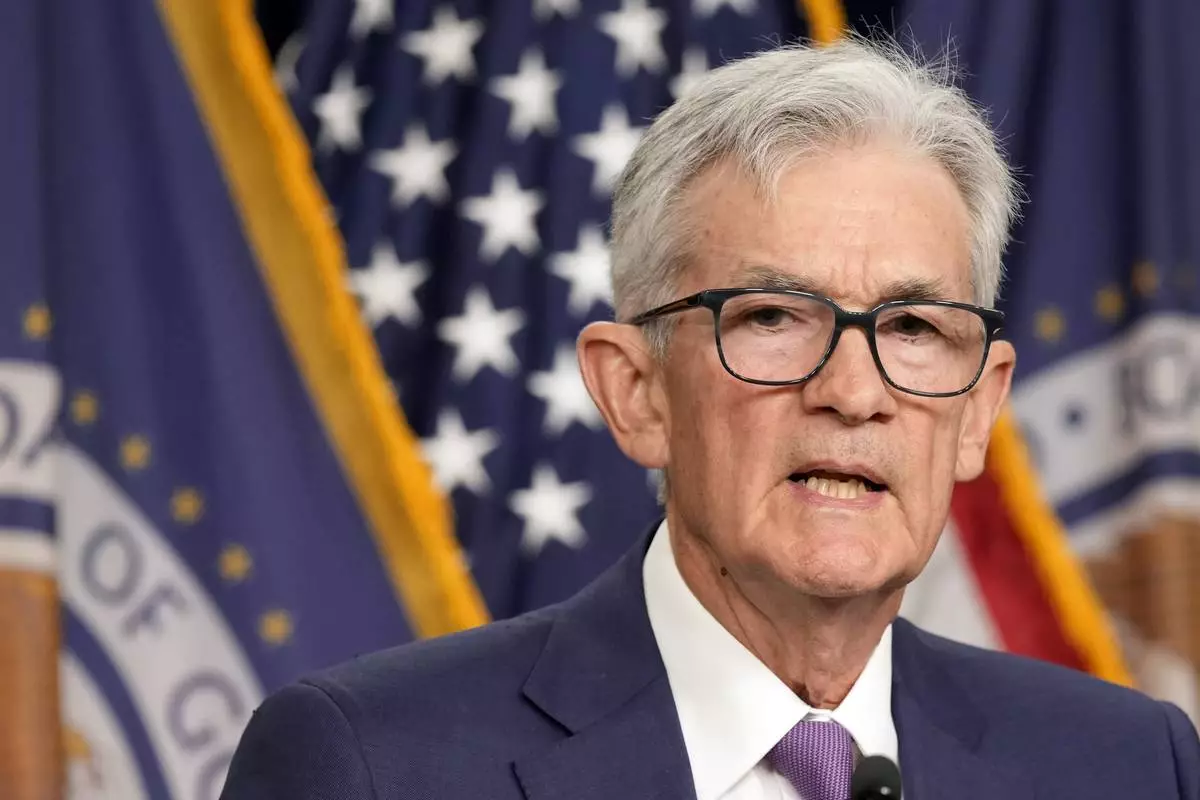
FILE - Federal Reserve Chair Jerome Powell speaks during a news conference at the Federal Reserve in Washington, May 1, 2024. (AP Photo/Susan Walsh, File)








